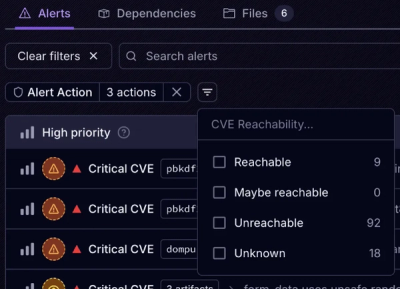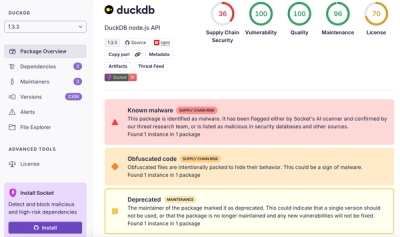
Product
Introducing Tier 1 Reachability: Precision CVE Triage for Enterprise Teams
Socket’s new Tier 1 Reachability filters out up to 80% of irrelevant CVEs, so security teams can focus on the vulnerabilities that matter.
github.com/chriscamargo/framer-viewNavigationController
fVNC is a simple view controller for FramerJS that allows you to transition between views with just a couple lines of code.
up, down, left, or right transitions.animationOptions.Step 1: Include the module in your protoype.
{ViewNavigationController} = require "ViewNavigationController"
Step 2: Create a new view controller.
vnc = new ViewNavigationController
In this case, I've called my view controller vnc. By default, the view controller will match the size of the device's screen. You can add width and height properties to modify the size of the view controller.
Step 3: Create your views and add them to the view controller.
myFirstView = new Layer
name: "initialView"
width: 750, height: 1334
image: "images/screen01.png"
parent: vnc
mySecondView = new Layer
width: 750, height: 1334
image: "images/screen02.png"
parent: vnc
To add them to the view controller, just make sure the it's their parent. You can see I've also set the name property of myFirstView to initialView. This tells the view controller that I want to start with this view appearing first.
Step 4: Set up a button to change views.
myButton = new Layer
width: Screen.width
height: 88
y: 1130
parent: myFirstView
myButton.on Events.Click, ->
vnc.transition(mySecondView)
Now I can quickly create a button that causes our view controller to change views. I don't need to worry about creating a 'back' button for mySecondView, the view controller has already done that for me. And if I add more views and create more transitions, the view controler will remember which views I've seen, and will step me back in the correct order.
fVNC comes with a few methods built-in to help you do things like transition backward, or remove the automatically created back buttons from an existing view.
To move backward by one history item, simply call the back() method.
myBackButton.on Events.Click, ->
vnc.back()
Just remember, if there's no prior view in the history stack, there's nothing to go back to, so nothing will happen.
To remove the back button from a view, just call removeBackButton() and pass in the view you'd like to affect.
vnc.removeBackButton(mySecondView)
This code will prevent the back button from appearing on mySecondView.
If you'd like to see new features added to fVNC, just drop me a line on Twitter (@chriscamargo), or better yet, submit a pull request.
change:view event to notify you when a view change happens.removeBackButton method. Thanks to @geligelu for finding and reporting this one.FAQs
Did you know?

Socket for GitHub automatically highlights issues in each pull request and monitors the health of all your open source dependencies. Discover the contents of your packages and block harmful activity before you install or update your dependencies.

Product
Socket’s new Tier 1 Reachability filters out up to 80% of irrelevant CVEs, so security teams can focus on the vulnerabilities that matter.

Research
/Security News
Ongoing npm supply chain attack spreads to DuckDB: multiple packages compromised with the same wallet-drainer malware.

Security News
The MCP Steering Committee has launched the official MCP Registry in preview, a central hub for discovering and publishing MCP servers.